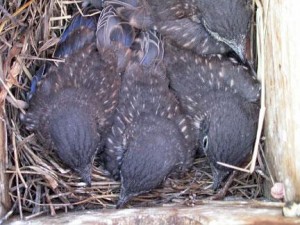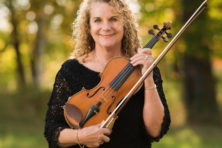Door to Nature
- Share
- Tweet
- Pin
- Share
International Earth Day and the first day of Spring, our Vernal Equinox – what an ideal time to pledge to devote more concerted effort toward helping improve some element of nature.
One distinct possibility comes to mind, that of using the Eastern Bluebird as a conservation model with which to bring you and your friends together and to raise awareness for the conservation of other species, especially birds. By the way, Earth Day in the United States will be celebrated April 22, while March 20 involves the whole wide world.
Having talked to and listened to many people who have been involved with helping bluebirds for more than 25 years, our Eastern Bluebirds of Wisconsin absolutely depend upon human intervention for their greatest success. This is where you can enter the widely-acclaimed program. The largely migratory bluebirds often begin to trickle back into Door County before the end of the third week of March and by the middle of April a large percentage of them have mated and are establishing their nesting territory. We have had a small number of these birds incubating eggs as early as April 15 in past years.
What is especially fascinating and challenging is learning to think like a bluebird in order to maximize your efforts to help them with their nesting. Just as humans have very identifiable necessities for raising a family, so do the bluebirds. Bluebirds in our state before the arrival of the white man nested in natural cavities including hollowed out tree trunks or branches. My dad and his family on the farm, dating back to the early 1900s, didn’t build nest boxes for the birds but nevertheless had bluebirds nesting at their place practically in their front yard. Those nesting sites consisted of the rotten hollowed-out tops of cedar fence posts. Bear in mind that House Sparrows and European Starlings had not yet arrived in their area, so the bluebirds experienced very little competition for nesting sites from these strong aggressive aliens.
Your number one priority will be to provide the bluebirds with nest boxes. One of at least three or four different styles will suffice. The North American Bluebird Society (NABS) plan is very popular and works well as does the plan we tend to favor, the K-style (Kentucky) box. Plans are readily available as are some houses for sale. Ask around, or give me a call. I and a few friends have gone one step further by using full one-inch-thick Eastern White Cedar lumber, available on special order from some sawmills, and also are building them to have both a top opening for the best and safest monitoring, and a side opening, most efficient and easiest for cleaning out after each brood.
The site in which you place your bird boxes is of paramount importance. An opening generally facing east, to catch the first warming rays of sun on cold mornings, tends to have the best overall success. A house mounted in such a way that it prevents predators from reaching the eggs is very vital. Being easy to climb, a wooden post or trees are the worst choices unless they are properly provided with baffles. PVC pipe surrounding a metal electric fence post, or a piece of metal electric conduit slid over a piece of concrete reinforcing rod (rebar) both work well.
Adult bluebirds must be able to readily find food for themselves as well as their babies in the nest. They are insect hunters who prefer to be able to perch on, for example, dead tree limbs and branches, telephone or electric wires, fences, TV antennas, roof edges, etc. and swoop down to capture their prey on the ground. They have to be able to see the insects they are pursuing. The birds usually don’t hunt in tall grass but rather short grass including areas which have been mowed along roadways, people’s lawns etc. This is precisely why being close to rural fence lines bordering roads, mown rural or suburban lawns or golf courses are usually such good nesting sites for these popular birds.
Mounting a simple five-foot-tall perch 20 – 30 feet directly to the front of the box entrance will prove to be very attractive and will often be used by the adult birds. They appear to like to perch momentarily before entering their boxes. Likewise of importance is a large tree around 20 to about 100 feet, to the front of the box entrance hole. This is vital in that the young, upon leaving the box on their “maiden” flight, must be able to fly directly to good perches where they will remain for several days while being fed and looked after by the adults. We prefer to aim the box entrance directly toward a tree, even though it is not due east but slightly one way or the other. There have been cases in which we had no choice but to face a box north, south or west, due to lack of trees to the east, and they usually work out satisfactorily.
Placing your boxes near brushy areas invariably will attract House Wrens. Yes, they are valuable and protected songbirds, but we are interested in helping the bluebirds. House Wrens often remove bluebird eggs or damage bluebird nests. The closer you are to bodies of water the more likely you will be to have Tree Swallows take over the boxes. They are also valuable and need nesting sites.
Accurate and regular monitoring of your nest box (or boxes) is absolutely vital. If you plan to simply to be a “good person” and put up a box with no intentions whatsoever of doing weekly monitoring, we suggest that you not put up the nest box. You might do a great injustice to the bluebirds in numerous ways. A good suggestion is to get in contact with someone with experience in monitoring bluebird boxes and quickly learn from them. It requires commitment on our part but is not difficult.
The organization we belong to, and praise highly, is the Bluebird Restoration Association of Wisconsin (BRAW). They have a very helpful Web site: http://www.braw.org. Join this group and you will receive extremely well written and up-to-date materials and an excellent quarterly newsletter that will help you to become a successful “bluebirder.” Charlotte and I are beginning our third season as BRAW’s Door County coordinators of people having nest boxes out for the Eastern Bluebirds. We are willing to help you.
Among our most favorite of all the volunteer groups we’ve been involved with through the years, the BRAW group ranks near the top. What’s so amazingly wonderful is that the members are so great to work, meet and learn with, while at the same time you are expending effort to help one of the finest birds in Wisconsin, the Eastern Bluebird. Please make them one of your top priorities this year. Someone up there will like you!






